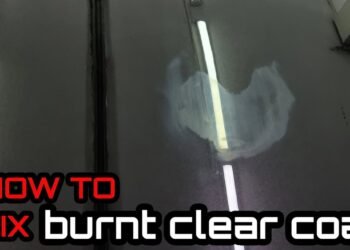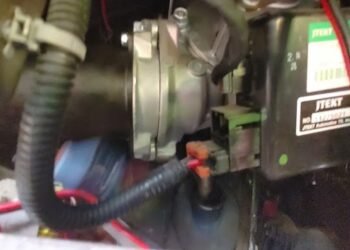Have you ever considered using lacquer thinner to clean stubborn spots on your car’s paint? It might seem like a quick fix, but what if it actually harms your car’s finish instead?
Lacquer thinner is a powerful solvent that can easily damage your vehicle’s paint, leaving it dull, hazy, or even permanently marked. If you care about keeping your car looking sharp, understanding how lacquer thinner interacts with your paint is crucial.
You’ll discover why lacquer thinner can be risky, when it might be used safely, and how to protect your car’s finish if you decide to use it. Keep reading to save your paint job and avoid costly mistakes!

Credit: www.corvetteforum.com
Lacquer Thinner Effects
Lacquer thinner is a powerful chemical often used to clean paint tools and remove stubborn paint spots. Its effects on car paint can be severe and harmful. Understanding these effects helps protect your vehicle’s finish from damage.
Strong Solvent Action
Lacquer thinner acts as a strong solvent. It breaks down paint layers quickly. This solvent power dissolves both clear coat and base paint. The paint can lose its shine and become dull. Extended exposure worsens this damage. The thinner can eat through protective layers on the car.
Paint Surface Damage
Using lacquer thinner on car paint can cause visible damage. The surface may develop white spots or hazy patches. These marks appear because the thinner removes essential layers. The paint loses its smooth and glossy look. Over time, this leads to permanent discoloration. The damage often requires professional repair to fix.
Impact On Plastics And Rubber
Lacquer thinner does not only harm paint. It also damages plastics and rubber parts around the car. Bumpers, trim, and seals can melt or crack. This weakens these materials and shortens their lifespan. Care must be taken to avoid contact with these parts. Damage to plastics and rubber can be costly to replace.
Situations For Use
Lacquer thinner is a strong chemical solvent. It can damage car paint if not used carefully. Knowing when to use it helps avoid harm. Use it only in specific situations. These include removing paint transfer, eliminating stubborn spots, and as a last resort for tough stains. Always apply lacquer thinner with caution to protect your car’s finish.
Removing Paint Transfer
Paint transfer happens when another vehicle’s paint sticks to your car. Lacquer thinner can remove this paint transfer effectively. Use a microfiber towel with a small amount of thinner. Rub gently to lift the paint transfer without harming the original paint. Do not pour thinner directly on the car. Always test on a hidden spot first.
Eliminating Stubborn Spots
Some spots like tar, glue, or sap may not come off easily. Lacquer thinner can break down these stubborn stains. Apply it sparingly with a soft cloth. Work quickly and avoid leaving it too long on the paint. After removing the spot, polish the area to restore shine. This method removes tough marks without heavy scrubbing.
Last Resort Applications
Use lacquer thinner only as a last option. When other cleaners fail, it can remove overspray or old paint blobs. This solvent is harsh and can damage paint if overused. Always protect plastic and rubber parts nearby. After application, apply wax or polish to protect the finish. Handle with care and use protective gloves and masks.
Damage Prevention
Preventing damage from lacquer thinner on car paint requires careful steps. Using lacquer thinner carelessly can harm your vehicle’s finish. Follow these tips to protect your car’s paint and keep it looking good.
Testing In Hidden Areas
Always test lacquer thinner on a small hidden spot first. Choose a place like under the hood or inside the door frame. This helps you see how the paint reacts before using it on visible areas. If the paint shows signs of damage, avoid using thinner there.
Controlled Application
Never pour lacquer thinner directly onto the car paint. Instead, dampen a microfiber cloth or cotton swab lightly. Apply the thinner gently and only on the affected spot. Using too much thinner can quickly dissolve the clear coat and paint layers.
Quick Treatment
Work fast when using lacquer thinner. Rub the area gently but quickly, then wipe it off immediately. Leaving the thinner on the paint for long causes more damage. Speed reduces the chance of dull spots and hazy patches forming.
Restoring Paint Finish
After using lacquer thinner, the paint may lose its shine. Use polish or wax to restore the finish. Polishing smooths the surface and removes dullness. Wax adds a protective layer and brings back gloss. This step keeps your paint looking fresh and bright.
Safety Precautions
Wear gloves and eye protection when handling lacquer thinner. Use it in a well-ventilated area to avoid inhaling fumes. Keep it away from plastics and rubber parts as it can melt them. Follow all safety instructions on the product label carefully.
Alternatives To Lacquer Thinner
Using lacquer thinner on car paint can cause serious damage. It strips away the protective layers and dulls the finish. Safer options exist to clean and restore your vehicle’s surface. These alternatives protect your paint while still removing dirt and stains effectively.
Gentler Cleaning Methods
Soap and water remain the simplest way to clean car paint. Use a mild car shampoo with a soft sponge or microfiber cloth. This method removes dirt without harming the paint or clear coat. For tougher spots, try a clay bar. It lifts contaminants gently without chemicals. Always rinse thoroughly and dry with a clean towel. Avoid harsh scrubbing to protect the finish.
Professional Detailing Products
Car care brands offer products designed specifically for paint protection. Paint cleaners and polishes remove stains without stripping paint layers. Use products labeled safe for automotive finishes. Detail sprays and quick detailers help maintain shine between washes. These products improve gloss and remove light dirt safely. Follow the instructions carefully for best results. Investing in quality detailing items prolongs your car’s paint life.
Signs Of Paint Damage
Paint damage from lacquer thinner often shows clear signs. Recognizing these signs early helps protect your car’s finish. Damaged paint looks different than normal paint. It loses its shine and smoothness. Noticing subtle changes can save costly repairs later.
Dullness And Haziness
One common sign of damage is dullness. The paint loses its bright and shiny look. It appears flat and lifeless instead. Haziness also shows up on the paint surface. This looks like a cloudy film or fog. It reduces the clear coat’s gloss and depth. Dull and hazy paint means the thinner has broken down the protective layers.
White Marks And Discoloration
White marks often appear after lacquer thinner contact. These spots look like small, chalky patches on the paint. Discoloration may also happen, causing uneven color. The paint may lighten or change shade. These changes show the thinner has damaged the paint’s base and clear coats. White marks and discoloration are signs of serious paint harm.
Plastic And Rubber Wear
Lacquer thinner does not only harm paint. It also affects plastic and rubber parts on the car. These materials can soften, crack, or melt after contact. The damage may show as faded, sticky, or brittle surfaces. Plastic trims, seals, and rubber gaskets are vulnerable. Wear on these parts indicates the thinner has been used incorrectly or too much.

Credit: www.reddit.com

Credit: eaglenationalsupply.com
Frequently Asked Questions
Does Lacquer Thinner Damage Car Paint?
Yes, lacquer thinner can damage car paint by dissolving clear coat and base layers. Use it sparingly and test first. Always polish and wax afterward to restore the finish. Avoid prolonged contact to prevent dullness, haziness, or damage to plastic and rubber parts.
How To Remove Clear Coat From Car Without Damaging Paint?
Use fine-grit sandpaper or a chemical clear coat remover carefully. Test on a small area first. Avoid harsh solvents like lacquer thinner to prevent paint damage. Work slowly and finish by polishing to restore shine.
Will Lacquer Thinner Damage Car Paint Reddit?
Yes, lacquer thinner can damage car paint by dissolving clear coat and base layers. Use it sparingly and test first.
Does Lacquer Thinner Remove Clear Coat From Car?
Yes, lacquer thinner can remove a car’s clear coat because it is a strong solvent that dissolves paint layers. Use it cautiously to avoid damage.
Does Lacquer Thinner Damage Car Paint?
Yes, lacquer thinner can dissolve clear coat and base paint, causing dullness or white marks.
Conclusion
Lacquer thinner can seriously harm your car’s paint if used carelessly. It dissolves clear coats and base paint quickly. Use it only in small amounts and test on hidden spots first. Always clean and polish the area after using thinner to restore shine.
Avoid contact with plastic and rubber parts to prevent damage. Protect yourself by wearing safety gear during use. Choose gentler cleaning methods whenever possible to keep your car’s paint safe and bright.

















